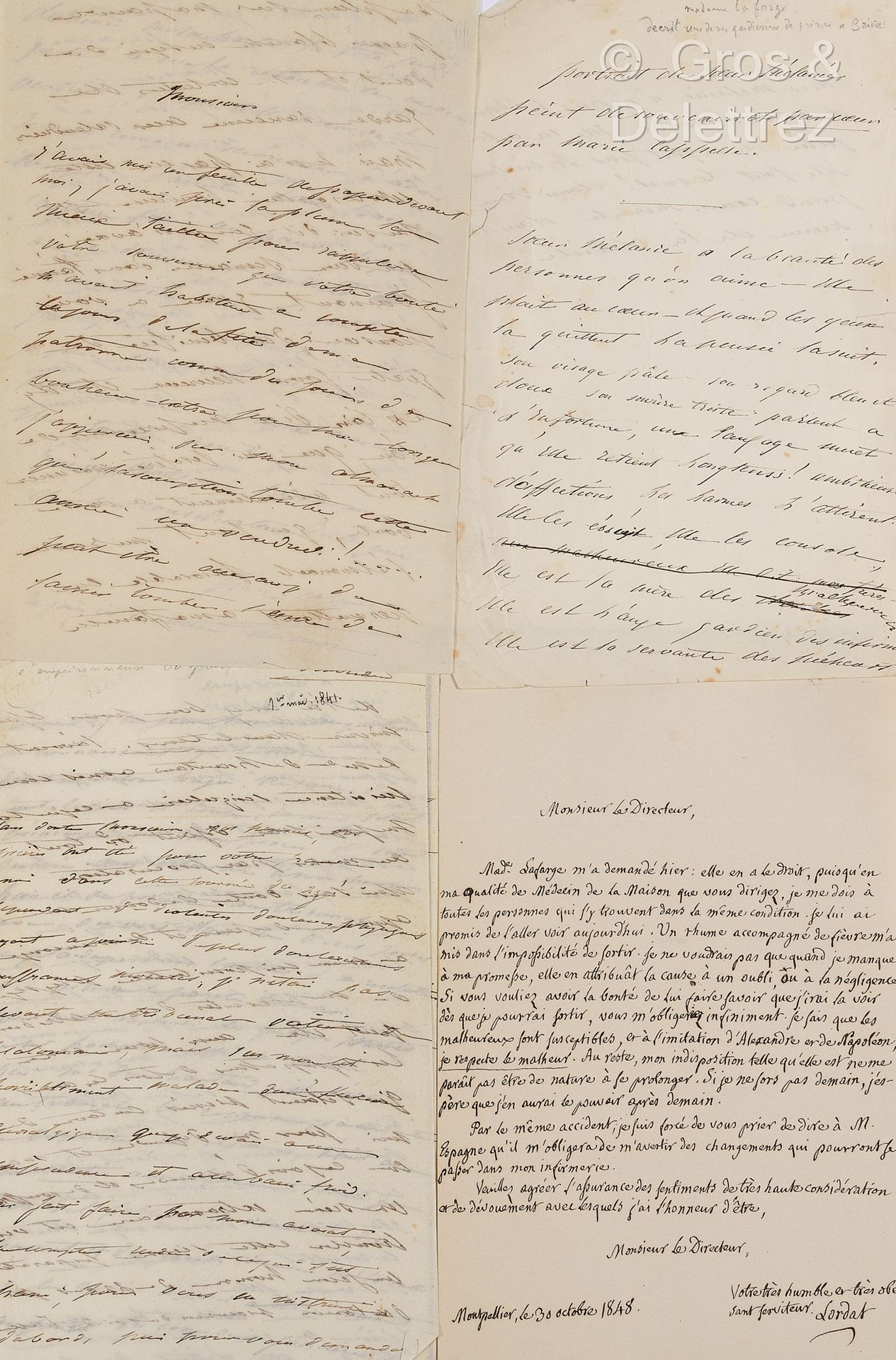Description
LAFARGE, Marie, née Capelle (1816-1852), famous poisoner. Set of 3 documents. Tears and restorations, not missing. -L.A. [to the journalist Théophile Mercier?] [Tulle], May 1, 1841. 4 pp. in-8. Beautiful letter written from the prison of Tulle, where she was incarcerated for the theft of the jewels of Mme de Léautaud. The accused says that she suffers from violent moral and physical pains and evokes the trial: " The lawyer of Mrs. de Léautaud put a singular insistence to have me judged in absentia or at least by proxy, in order undoubtedly to give an appearance of fear and lie to my physical impossibility to appear before the court ". She then tells the curious intervention of a young stranger, during the jury, to plead for her with vehemence. -L.A.S. S.l.n.d. 4 pp. in-8. She wishes to have the chance to see her family to celebrate New Year's Day and talks about her prison life: "I thank you, Sir, for having understood the friendship of a poor captive for a poor pigeon. We discovered his nest, his mistress gave it to me [...]". -P.A. entitled "Portrait of Sister Melanie painted from memory and by heart by Marie Cappelle". S.l.n.d. 1 p. 1/2 in-8. Scratches and corrections. The captive Marie Lafarge paints a beautiful portrait of one of her guards in the prison of Brive. "Sister Melanie has the beauty of the people we love - she pleases the heart and when the eyes leave her the thought follows her, her pale face, her blue and sweet look [...]. She is the mother of the unfortunate, the guardian angel of the unfortunate [...]". We enclose: -a L.A.S. from the French surgeon and physician, pioneer of neuropsychology, professor of anatomy, surgery and physiology, Dr. Jacques Lordat (1773-1870), dean faculty of Montpellier. It is addressed to M. de Villars, director of the Maison Centrale of Montpellier. Montpellier, October 30, 1848. 1 p. in-8. Envelope preserved. Suffering, he will not be able to visit Marie Lafarge, despite his promise. He wants to inform her of it by rightness, hating to fail in his promises "in the imitation of Alexander and Napoleon I respect the misfortune". -an engraved portrait of Marie Lafarge.
91
LAFARGE, Marie, née Capelle (1816-1852), famous poisoner. Set of 3 documents. Tears and restorations, not missing. -L.A. [to the journalist Théophile Mercier?] [Tulle], May 1, 1841. 4 pp. in-8. Beautiful letter written from the prison of Tulle, where she was incarcerated for the theft of the jewels of Mme de Léautaud. The accused says that she suffers from violent moral and physical pains and evokes the trial: " The lawyer of Mrs. de Léautaud put a singular insistence to have me judged in absentia or at least by proxy, in order undoubtedly to give an appearance of fear and lie to my physical impossibility to appear before the court ". She then tells the curious intervention of a young stranger, during the jury, to plead for her with vehemence. -L.A.S. S.l.n.d. 4 pp. in-8. She wishes to have the chance to see her family to celebrate New Year's Day and talks about her prison life: "I thank you, Sir, for having understood the friendship of a poor captive for a poor pigeon. We discovered his nest, his mistress gave it to me [...]". -P.A. entitled "Portrait of Sister Melanie painted from memory and by heart by Marie Cappelle". S.l.n.d. 1 p. 1/2 in-8. Scratches and corrections. The captive Marie Lafarge paints a beautiful portrait of one of her guards in the prison of Brive. "Sister Melanie has the beauty of the people we love - she pleases the heart and when the eyes leave her the thought follows her, her pale face, her blue and sweet look [...]. She is the mother of the unfortunate, the guardian angel of the unfortunate [...]". We enclose: -a L.A.S. from the French surgeon and physician, pioneer of neuropsychology, professor of anatomy, surgery and physiology, Dr. Jacques Lordat (1773-1870), dean faculty of Montpellier. It is addressed to M. de Villars, director of the Maison Centrale of Montpellier. Montpellier, October 30, 1848. 1 p. in-8. Envelope preserved. Suffering, he will not be able to visit Marie Lafarge, despite his promise. He wants to inform her of it by rightness, hating to fail in his promises "in the imitation of Alexander and Napoleon I respect the misfortune". -an engraved portrait of Marie Lafarge.
You may also like
